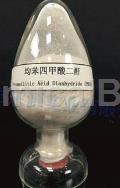Background and overview[1][2]
Pyromellitic acid diamine is an amine organic compound that can be used as a fast-acting inhibitor of methane production.

Apply[1-2]
1. The currently used rumen methanogenesis inhibitors mainly include monensycin, halides, nitro compounds, plant extracts, etc. Monensycin is widely used and can reduce methane production in animals by 30%, but the inhibitory effect is not long-lasting. Chloral hydrate is converted into chloroform in the rumen, which can reduce the production of methane in the body. However, chloral hydrate damages the liver, and long-term feeding can cause animal poisoning or even death; trichloroacetyl, trichloroethyladipic acid and bromochlorine The effect of methane on inhibiting methane production is short-lived; sodium 2-bromoethanesulfonate (BES) is an effective CH4 inhibitor and does not inhibit the growth of other bacteria.
In vivo tests found that its inhibitory effect is short-lived, and it is possible that methanogens have developed resistance to BES. When nitroethane, 2-nitroethanol, 2-nitro-1-propanol, pyromellitic acid diamine and sodium 2-bromoethanesulfonate are used alone, Anderson et al. reported that alfalfa was used as the fermentation substrate. , Nitroethane, 2-nitroethanol and 2-nitro-1-propanol can inhibit ruminal methanogenesis by more than 90%, 80% and 70% respectively in vitro; Van Nevel and Demeyer reported that pyromethane Formic acid diimide can inhibit 97% of methane production in vitro; Nollet et al. reported that sodium 2-bromoethanesulfonate can also inhibit more than 90% of methane production in vitro. However, the effect of these inhibitors alone is not long-lasting. The combination of these five inhibitors not only has a good inhibitory effect (more than 90%, up to 99.5%), but also makes methanogens less likely to develop resistance. This combination is There have been no reports at home or abroad.
CN200910089581 provides a compound methane production quick-acting inhibitor and its preparation method and use, so as to achieve the purpose of efficiently inhibiting methane production. The compound quick-acting methanogenic inhibitor is divided into two parts, A and B: A is liquid, slightly light yellow, and its main components include nitroethane, 2-nitroethanol and 2-nitro-1-propanol; B is an off-white solid powder whose main ingredients include pyromellitic acid diamine and sodium 2-bromoethane sulfonate.
The beneficial effect of the present invention is that the composite methanogenesis quick-acting inhibitor of the present invention does not require the type and concentration of nitroethane, 2-nitroethanol, 2-nitro-1-propanol, and pyromellitic acid. The compatibility of diimide and sodium 2-bromoethane sulfonate has an extremely significant methane inhibition effect. It is especially suitable for inhibiting methanogenesis in the rumen, which is beneficial to protecting the environment and improving the energy utilization efficiency of ruminant feed. The preparation method is simple and It has strong operability and is suitable for livestock and poultry breeding industry feed processing, livestock and poultry excrement biogas treatment and urban domestic garbage biogas treatment. The inhibition efficiency of microbial methane production reaches more than 90%, and has high practical value.
2. Zhang Hairong and others used pyromellitic acid diamine (PMD) as raw material and used vacuum vapor deposition method to prepare PMD nano self-assembly materials, thus establishing a new fluorescence chemical sensing method for measuring trinitromethane. The PMD nanomaterials were self-assembled using vacuum vapor deposition method, and the materials were characterized using scanning electron microscopy, transmission electron microscopy, infrared spectrum, ultraviolet spectrum, differential thermal analysis and fluorescence spectrum.
The scanning electron microscope image shows that the PMD nanomaterial has a ribbon network structure with a length of 30~100!m; the TEM image shows that the PMD nanoribbon width is 100~300 nm, of which the nanowire diameter is 120~220nm. In the self-assembly process of PMD molecules, weak interactions such as intermolecular hydrogen bonds and π-π are the main driving forces for building nanostructures. Some lower boiling point organic molecular vapors can quench the fluorescence (λex/λem=377 nm/495 nm) of PMD nanomaterials, especially PMD nanomaterials that respond sensitively to trinitromethane. The linear range of trinitromethane determination is 2.19×10-5~1.37×10-4mol/L, R2=0.995, and the detection limit is 1.02×10-6mol/L.
Main reference materials
[1] [Chinese invention, Chinese invention authorization] CN200910089581.X A compound quick-acting inhibitor of methanogenesis and its preparation method and use
[2] Zhang Hairong, Gao Denghui, Li Zhiying, Zhang Lixia. Preparation of pyromellitic acid diamine nanoparticles by vapor deposition methodMaterials and sensing applications[J]. Journal of Luminescence, 2018, 39(02):134-139.


